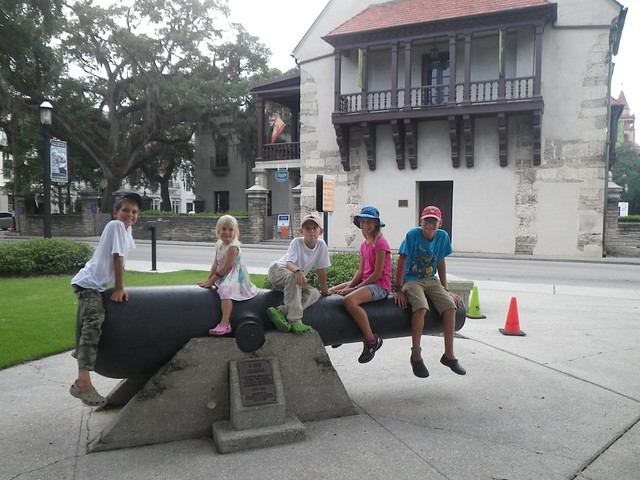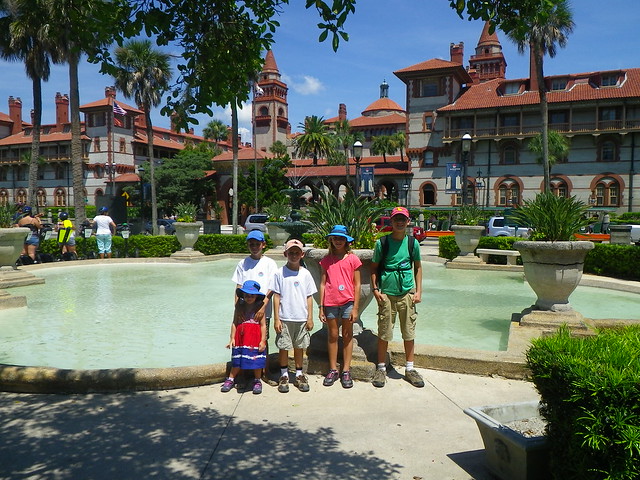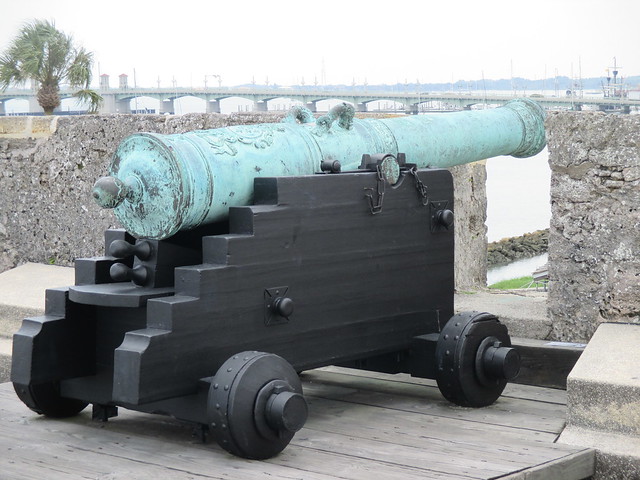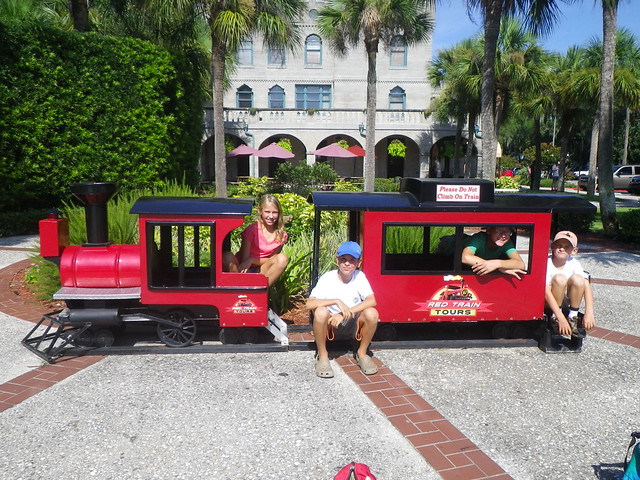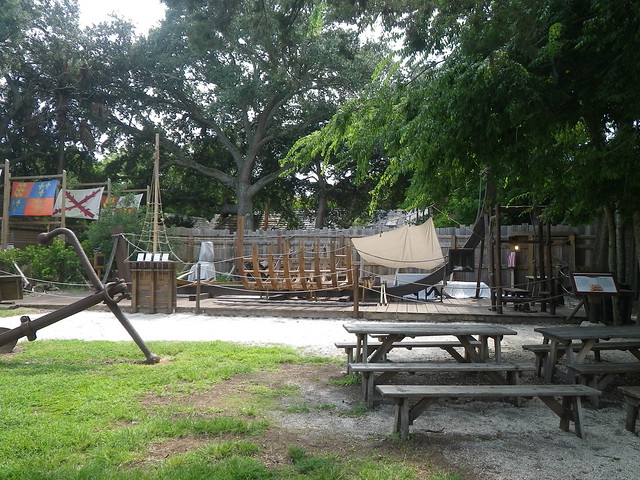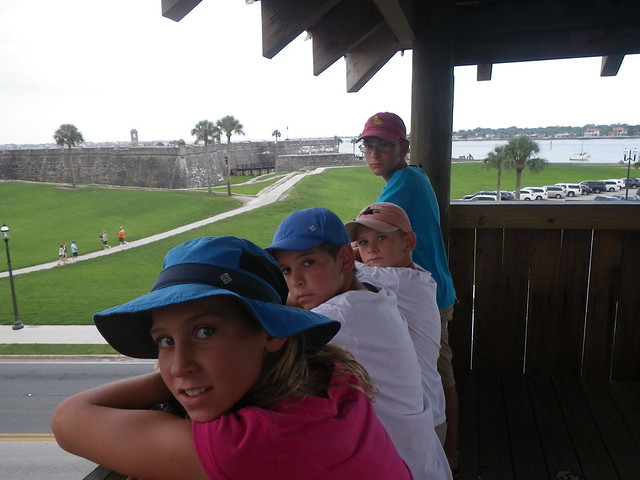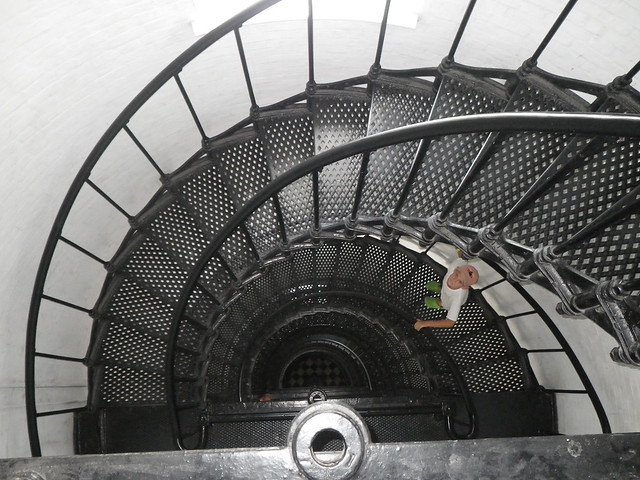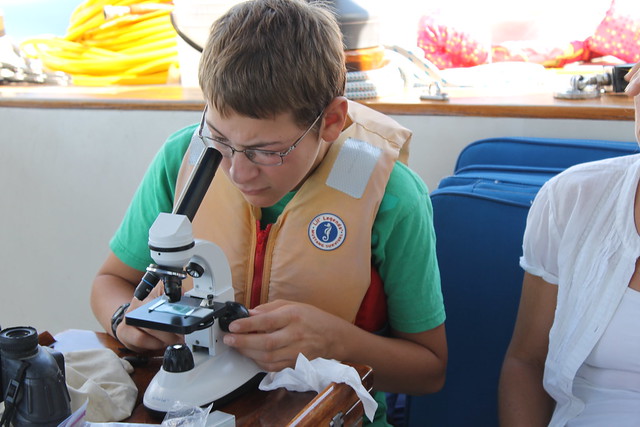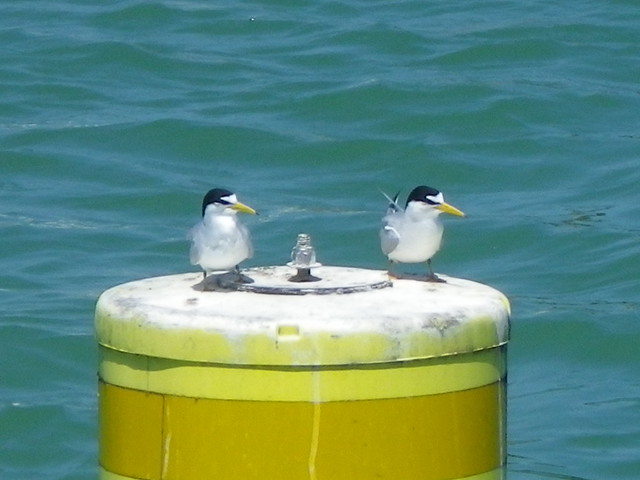August in St. Augustine |
Author Archives: Tanya
Rachel Swims! |
One of the most important milestones in our home is the day a child learns to swim. This, of course, is so that we don’t have to worry so much about little people going outside and falling into our front yard. Rachel has been in the water since she was days old—her swim lessons started with the teaching of survival skills, like floating on her back. When she fell off the dock last year, she did not panic, but popped to the surface and waited for help (only seconds away in that case). Since then, she has been a lot more careful on docks, and we have been pushing the swimming. By age two, she had all the requisite skills: floating, kicking, holding her breath, forward motion using her arms—but she had not put them all together. She would jump in the water, swim underwater until she ran out of air and we’d fish her out, spluttering. This summer, she added “coming up for air” to her repertoire. We’ve had access to a pool for the last couple of weeks, and her swimming has really improved. She’s comfortable jumping in the deep end and getting herself back to the ladder. I can tell you, we’re all celebrating that achievement and will sleep a little easier knowing that she’s joined our amphibious crew.
FAQ: How do you handle storms at sea? |
People often comment that we are brave to do what we do. If what they mean by brave is feeling afraid, but refusing to be ruled by fear, I might agree. One of the chief fears people have about boats is encountering storms at sea. We can often choose the weather in which we depart, but cannot control the weather we experience once offshore. And once you’re in it, like the children’s chant says, “you can’t go over it, you can’t go under it—you’ve got to go through it.”
Summer weather in Florida is pretty predictable. Except for during hurricanes (which you can plan and prepare for), the daily weather forecast is about the same. There are land and sea breezes which take shifts, a middle-of-the-day lull, and afternoon thunderstorms which can pack a mighty punch (we’ve seen wind speeds of up to 65 knots). Tied to a dock, these approaching storms are fun to watch—the cumulonimbus clouds building and billowing, the wind shifting and howling, and rain that is more waterfall than shower—all except for the lightning, which is indiscriminate and always terrifying if you live in a home with a 68-foot metal pole on top. At sea, I can attest, these storms are not to be trifled with.
I never feel more alive, or rather, more aware of the fragility of my life, than at sea in rough weather. I may be one of those rare, sick-minded people that feel a sort of exhilaration, even joy, in the midst of these storms. If I can’t control it, I can at least appreciate it. The wild beauty of foaming wave-tops, lightning that glows white-hot or pinkish-blue and hurts your eyes for its brightness, thunder that you can feel and not just hear—these are awesome forces to behold from the deck of a wave-tossed boat.
The children, sensing a change in the weather, naturally look to us for cues as to how to respond to what sometimes feels like an emergency. We may rush around for a few moments stowing loose objects, digging out rain gear, taking down sails, and starting an engine. But then I do something mundane, like wash dishes or read aloud, to send the message that it’s business-as-usual. If people feel fearful, we pray, and retell the Bible story of Jesus calming the storm with a few words, and wondering at the lack of faith in his anxious disciples. This story restores confidence, if not fearlessness, because it reminds us that we know the Maker of these forces and that we find ourselves in His capable hands, come what may.
Jay, as the captain, is usually at the helm in his foul-weather gear trying to keep the boat at a comfortable angle to the wind and waves. I can only imagine what impression this leaves on our young children, especially boys beginning to get a glimpse of manhood, to see their capable Dad seemingly in control, keeping his family safe and exuding calm and quiet. In reality, we dread sailing in rough weather. It is humbling and physically uncomfortable. But we also know that these experiences are making us tougher and more capable sailors. At the very least, our grandchildren will be regaled with good stories, because, as we have remarked before, it’s never the calm, quiet, boring days which make for good stories.
Bahamian Independence Day |
Into the Rabbit Hole |
Oh, how I look forward to long, boring passages. Really. Time seems to telescope as the instruments count the tenths of nautical miles to the destination. And what shall we do with all this time? Eat very slowly? Talk? Read aloud by the hour? Fish? Watch the fabric of the ocean for the interruption of flying fish or the dolphins of Happiness—or, maybe, if we’re lucky, a whale? Stare lovingly into the deep-blue water and wonder, "what are those specks floating all over the place?" This morning, as we glided over the glassy surface of the Gulf Stream, for lack of anything better to do, I grabbed a bucketful of water, dug the microscope out of the science bin, found some slides, a petri dish, and an eyedropper and opened the Ocean Lab.
This morning’s victim was what I might call a “Floating Puffball from Inner Space.” I suspected it to be algae of some sort. It was a globe of greenish-brown with fine hair sticking out in all directions, about the size of a poppy seed. I sucked it up into the eyedropper and deposited it on a slide in a drop of water. At 40X, it looked like a mass of very fine tangled hair. At 100X, I began to see other, smaller things moving in and out among the hairs, and at 400X, the thing looked like a forest with small animals running in and out of the trees, changing direction mid-stream, diving and flying between the foliage. Each tree trunk was a hair—it was only a few cells thick, and it was clear from the cellular structure that it was plant-kind, but there was movement within each stalk and each moved like a tree waving slowly in a breeze. The tiny one-celled creatures within the forest of algal stems moved with incredible speed and energy. I felt like I was looking at Horton’s Whos down in Whoville. It was mesmerizing.
Once, at a local farmer’s market, I bought a head of heirloom broccoli, not because I wanted to eat it, but because I wanted to look at it up close: its stalk was a perfect spiral staircase of florets, with each floret a perfect spiral of buds, and each bud, in turn, a spiral. It was a perfect fractal repeating to the microscopic level. We have, for school and for fun, looked at inner cheek skin cells (animal), onion skin (vegetable), salt crystals (mineral), a honey bee’s stinger (barbs on barbs!), tiny brine shrimp (with compound eyes), the statue of Lincoln inside his Washington D.C. Memorial (on a penny), no-see-ums (look at those jaws!), hairy spider legs, fleas, and anything else we could capture and study. The C & A Scientific “My First Lab” Duo-Scope portable microscope with battery-operated LED bulbs (allowing you to look at both opaque and translucent objects) is probably the best science purchase we have ever made. It is so easy to use that even the youngest of our children has been able to view the tiny things on the slide—with the instant reward of discovering something strange and new.
The more I stare at that bright circle at the bottom of the dark tube into the magical world of the unseen things, the more I wonder how deep the rabbit hole goes. If a tiny alga can be home to animals as numerous as squirrels in the woods, what else can be possible? I read that we are, by genetic material, only one percent human. That makes me a planet-home to microbes more numerous than the population of humans on earth. Is everything a microcosm—a world inside a world? I feel like a peeping Tom peering in at a Creation too great for my limited intellect. This is usually the point at which I have to put the microscope away and look at the horizon because I suddenly feel a bit dizzy.
Chore Chart |
Jay and I are both hard workers, and come from families that value hard work, but this value doesn’t appear to pass to the next generation through the genes; work has to be taught, and to people who really would rather lounge around and play all day with toys someone else paid for, eating food someone else prepared, wearing clothes someone else bought in a home that someone else keeps tidy. But to enter into the life of a family one has to do the work of the family. And real life doesn’t reward sluggards, either. To the best of our ability, we will raise people who can leave our home able to do a myriad of jobs, efficiently and with expertise.
One way we do this is with the chore chart. People ask us how we can have five children on a sailboat, and one answer is that everybody has to pull their own weight. Of course, a 3-year-old “helping” with the dishes is hardly the same thing as a nearly-13-year-old scrubbing down the cockpit, but the principle is the same: if you don’t work, you don’t eat.
A lot of training is required to get the kids to be actually helpful, so that Jay and I don’t feel the need to go around behind them “fixing” things. For a while at least, it is harder to help a kid learn a chore than to just do the chore yourself, but doing it for them or cleaning up after them would be shooting yourself in the foot long-term. A kid who is given a token chore will quickly learn to slack off—if they know you’re going to go back and do it better later, why bother doing it at all? But teaching a kid to do a task and requiring it to be done to your satisfaction is an investment that pays off pretty quickly. I read recently about the Amish expectations of children: a child is a net “loss” for the first six years, but a seven year old “breaks even” (contributes as much as he costs) and by ten, an Amish girl can do all the tasks her mother can, a boy can work a full day on the farm, and they are giving back to the family—a net “gain.” We’re not Amish, but we do have high expectations for our children—we‘re banking on the principle that early training equates to later independence.
A crew member on Take Two gets his or her first official duties at three years old. Rachel just made the chart for the first time. She helps with groceries, sets the table, washes windows, folds kitchen towels, and puts away forks and spoons. The older kids are used to hard work at this point, although they still complain from time to time (complaining usually earns them an extra job). They vacuum the whole boat, do dishes, load and unload the dinghy, take trash ashore, scrub decks, set up for and clean up after meals, and stay on top of the laundry. One would think that I would have time to sit in my hammock more often now that I have such able helpers, but actually, their taking some of the cleaning chores frees me up to do other tasks, like reading with Rachel and schooling Sam, making homemade tortillas or baking bread, writing, or helping Sarah with her quilting project.
For years we have used a monthly rotation with each person getting four or five jobs (some require teamwork) because we found that a month is long enough to get really good at a chore, but not long enough to grow bored with it. We’re doing an experiment this summer with quarterly chores; the kids had more input as to which chores they like to do and I got to assign some chores according to who is the most capable at each task. We’ll have another family meeting in the fall to decide if that system is working.
If someone shirks a chore, there are real and immediate consequences. A chore half-done must be re-done, a chore forgotten costs one a “reminder fee” of 50 cents, and a chore done with a bad attitude earns one more chores. We do offer a monthly allowance to teach money management, but that assumes that the kids are meeting expectations—keeping their cabins tidy, folding and putting away their own laundry, helping with meals, and doing assigned chores “immediately, cheerfully, and quickly.”
Another of our favorite sayings is “Work hard, play hard.” When the work gets done quickly, there’s time left over for skating at the park, snorkeling on the reef, surfing at the beach, riding horses, kayaking, and lots of other adventures, the natural rewards of a job well done.
Terns of Endearment |
It is Tern mating season. Here in the Keys, we have Lesser Terns, and their “hotel room” of choice is the yellow E or J bouy that marks the extremity of the mooring field, usually off of one of our sterns. Imagine trying to teach astronomy or Greek mythology and being constantly interrupted by a sound not unlike squeaky bedsprings—my lessons are relegated to basic “birds and bees” biology.
We’ve had lots of time to observe mating behavior as we homeschool in the cockpit on these lovely spring mornings. Their routine goes something like this: the male and female bird stand side by side on the poo-encrusted buoy, bobbing wildly in the wind and chop and fishing-boat wakes. They begin by bowing politely and singing a squeaky little song back and forth to each other. Then the male bird disappears for a few minutes and comes back with a small bait-fish (still wiggling) in his beak, which the female bird tries to grab, but which he successfully keeps just out of reach. They then bow and chirp a few more times, after which she ruffles her feathers as a sign of assent and he responds by flapping wildly and trying to balance while reenacting that timeless dance of love—getting her to hold still by offering the fish at just the right moment. It lasts mere seconds, and then he flies away. She cries disconsolately. (Pardon my anthropomorphism, but doesn’t it sound familiar?)
But this is not the end of it! She continues to call for him, and, sure enough, he comes back—with another fish in his maw, which he offers this time without requiring anything in exchange. He does this not once, but over and over and over again. One morning we noted a male who came back to his sweetheart with a dowry of 19 little fishes before they flew off together, ostensibly to their waterside nest somewhere to start a family. Now here’s a strange wooing-in-reverse; usually the male must prove his worthiness before the wedding night, not after!
One morning, as we watched the process for the umpteenth time, Rachel looked at me sadly and said, “Why did the daddy fly away?” I was startled by her response, but Jay’s recent travel schedule has made her sensitive to separation. She was on the verge of tears, so I had to come up with a reassuring answer quickly. “He’s not gone-gone. He’ll come back in a minute with a little fish. Just wait and see.” The relief was visible in her face when, just as I promised, the daddy came back and offered his prize. I asked her, “Doesn’t your daddy fly away on the airplane? And doesn’t he always come back with money to buy food? He’s just like the daddy bird.” Satisfied, she toddled off to play with her Legos while we continued with school and chores. If only all of life were that simple.
The Grass is Greener |
The Grass is Greener on the Other Side of the Hill: a Poem for Jay's 39th Birthday
You’re at the peak of the hill,
You’re at the top of your game.
And after the climb,
I still feel the same:
So much to look back on,
So much still to do,
I’m right where I should be,
On the hill-top with you.
No regrets lurk behind us
No fears lie ahead—
(We made it this far!
We did what we said.)
No matter what the future holds,
Be it joy or sorrow,
I’ll gladly go down-hill with you
On into tomorrow.
Sailing Promise: A Book Review |
Every couple living aboard a small boat who spends any time on the ocean will recognize that there are circumstances which test the relationship. We know lots of single-handers whose spouse jumped ship after a long passage. In her book, Sailing Promise, Alayne Main tells the story of her circumnavigation with husband Alec in the 90s aboard a Prout 33 named Madeline. While the book chronicles their travels—new places, new friends, new cultures—it also tells the inside story of how the journey affected their relationship. The following is a quote which sums up, for many, what it’s like to live in close quarters on a small boat with a spouse who may or may not handle stress well.
Despite my seasickness and the uncomfortable ride, it was only three days. Although many of the same fears plagued me, I could tough it out for a short passage…I thought of a girlfiriend of mine who had spent a year backpacking with her husband, spending 24 hours a day together, every day. She had said there wasn’t one moment when she wanted to be away from him. Envious as I was, our circumstances were vastly different. All my possessions, my lover, and I were contained inside a tiny 33-by-15-foot boat, which was put to the mercy of the wind, waves, and weather. The only certainties were that things would break and the wind would change. With an added dash of seasickness, a little thunderstorm or a ripped sail, a kind of stress was created that would cause even the most pleasant of people to get irritable. Alec and I dealt with stress differently and this often aggravated things even at the best of times (from the chapter entitled "Wild Horses").
Anyone considering a life aboard would be wise to read the book, whether they have dreams of circumnavigating or not. It is an honest look at a side of the sailing life you seldom see in a cruiser’s blog or travel book. Most of the people who buy a boat to travel the world think long and hard about what kind of boat they want, which of their belongings they want to keep and which to get rid of, where they want to go, how they will provision, what tools and gadgets they want aboard, and so forth and so on. But less thought is given to something that may have the greatest impact on whether the people going will be happy at all.
It is important to think about what isolation might do to your marriage, how each of you responds in a crisis, how well you communicate, what kind of outlets you or your spouse needs to reduce stress, how to find contentment in a difficult setting, and how to overcome fears and surmount obstacles so that you can strengthen your close relationship instead of tearing it apart. Through Alayne’s thought-provoking inner journey, it’s possible to envision how good communication and compassion can help two people pass the tests they will surely encounter on their adventures.
Overnight to Biscayne Bay |
Making a passage is like hitting the “pause” button on my life. It’s very hard to write in my Day-Timer: “sit in the cockpit and do nothing.” But sometimes that’s really what I should do. Feel the sun on my face, the wind in my hair, the weight of a child on my lap. Relax the rules that keep me sane during my quotidian life because this is not my quotidian life. Even rough passages, which are not very pleasant, have a way of making one sit still and appreciate life (large waves will do that). Overnight passages have the feel of a holiday—a holiday that you dread and anticipate at the same time. The passage we just made from Ft. Pierce to Biscayne Bay was in many ways typical of our other overnight passages. Here’s a peek into our life afloat:
9 AM A friend from the Keys texts us (again) wondering where we are and why we’re freezing our butts off in Ft. Pierce instead of heading south to hang out with them.
10 AM I abandon the attempt to make a big Sunday breakfast and feed everyone granola instead as Jay and I discuss using the weather window to head south.
11 AM Having decided to “just do it” we figure out what’s on the short list to prepare for departure. I will head to the library to drop off books, to a friend’s house to say good-bye and drop something off from my kids to hers and to the store for last-minute provisions. Jay will prep the boat for travel.
3 PM Hours later, I return with said provisions and we eat a late lunch, unpack groceries and run the engines.
4 PM We get fuel and water and do a pump-out at the marina. This always takes longer than we think it will. Debate ensues about whether we should go now or have a burger at the marina restaurant and wait until morning. We decide to use inertia and just go (“a boat tied to a dock stays tied to a dock; a boat in motion stays in motion). Good friends come down to see us off; it’s so nice to have someone to wave to (though we'll miss them before we're even out of the marina).
5 PM We head out the Ft. Pierce inlet, not into, but away from, a beautiful sunset. We make no commitments to really go until we see how the inlet looks. A blessing: the tide is running out and the seas are calm, the winds fair. We head south, hugging the coast to stay out of the north-flowing Gulf-Stream. We say a prayer of thanks and ask for safe travel. Then we toss Oreos into the sea and say, “May these be the last cookies we toss on this voyage!” (See previous post “Traveling Traditions.”)
6 PM We hang out in the cockpit and do nothing. Rachel falls asleep in my lap.
7 PM I make a quick dinner of tomato soup, goldfish crackers and applesauce and set up the kids’ traditional passage movie: The Swiss Family Robinson.
8 PM The wind is out of the southwest, but we can close-haul. We unfurl the jib and boost our speed, motor-sailing at about 6 knots. At this rate, we will not reach the entrance to Hawke Channel for 14 hours. A long, but calm trip. More wind would mean a quick trip, but also rougher waters. No one tosses cookies—YAY!
9 PM Moonrise: a beautiful orange pumpkin-shaped waning gibbous, perfect for a night sail. Jay plans our course and plots waypoints for Larry and Otto (a.k.a. Lowrance chart-plotter and autopilot) and heads to bed to get some sleep. I make a pot of coffee and get ready for my night watch. Kids eat Christmas candy and finish their movie. Rachel goes to her cabin, and the older boys head to theirs. Sam opts to sleep in the salon, and Sarah insists on bundling up and sleeping in the cockpit. No rules on passages.
10 PM Motor-sailing. I’m the only one up, enjoying my coffee, my snacks, my book and my choice of music. My favorite part of passage-making, even with the fluky wind (sheet in, ease out, furl, unfurl) and the nerve-wracking lights—is that a sailboat? A big ship? A beacon? No, an incoming airplane. It keeps me awake.
2 AM Jay comes upstairs to investigate the flapping sound (me furling the jib). He makes us roast beef sandwiches. I make a cup of hot cocoa and go back to the “hot seat.” Jay goes back to bed for another hour. (Long night watches mean we feel more rested the next day. We used to do three hours on/three hours off, but it leaves us feeling ragged, especially if we have multiple days at sea. We now do six-on/six-off at night and take turns napping during the day.)
3 AM Jay comes on watch and I go down below for some much-needed sleep. I was beginning to nod off in the captain’s chair despite the cold wind in my face. I set snooze alarms for myself at this time of night so that I will look up every 10 minutes in case I’m reading with my eyes closed.
7 AM Snuggle-time with Rachel. She informs me that the waves are not scary. They are just rocking her gently.
8 AM I get up and make a pot of tea and instant oatmeal for anyone who wants something quick and warm. We sit in the cockpit and do nothing. We’re approaching shipping channels at Port Everglades so we’re keeping a close watch.
9 AM Jay goes down below to nap. Everyone else reads or does nothing. Aaron, Sarah, and Sam split sunflower seeds and spit shells overboard, a favorite activity while sailing. Cleaning up sunflower seed shells off the side of the boat is a not-so-favorite activity when we get where we’re going.
10 AM Eli takes a watch so I can go make egg-and-ham-and-cheese sandwiches for hungry people.
11 AM Jay comes upstairs to eat something and take the wheel. We pass Port-of-Miami uneventfully. We sit in the cockpit and eat animal crackers. I notice Rachel yawning so we go down in my cabin and read books until we fall asleep.
12 PM The kids play electric guitar (Rocksmith).
1 PM I come upstairs with Rachel to make some lunch. The kids are still playing the guitar. We’re sailing along nicely, and thinking of heading into Biscayne Bay since we don’t motor in Hawk's Channel at night (too many crab pots). I make a snacky-lunch of hummus and veggies, olives, apples and peanut butter, and tortilla chips and crackers for dipping. Everyone loves this kind of lunch, and we only eat like this on a passage.
2 PM We motor into Biscayne Bay and play Farkle in the cockpit (a dice game to which the crew of Sea Hunt IV introduced us last year—thanks!).
3 PM Still motoring and doing nothing. We pass stilt houses and see people canoeing and paddle-boarding. Kids play guitar again. I play a memory/matching game with Rachel.
4 PM I make the kids put down the guitar and they play LEGOs on the dining table instead while I go out on the foredeck for some late-afternoon yoga. I discover that while I cannot do “Tree Pose” on land, I manage to balance on one foot without wobbling on the deck of a moving boat. Hmmm.
5 PM We pick a place to anchor for the night and I start dinner. The kids fish off the back of the boat.
6 PM The sun sets a fiery orange and we open a bottle of wine. We eat a dinner of pasta carbonara, broccoli, and garlic bread. Everyone is in a good mood, laughing and talking.
7 PM We look at The Stars book (by H.A. Rey) and I come up with a star-gazing challenge: who can find the Great Hexagon of bright stars in the Eastern sky? (The stars are Sirius in the constellation Canis Major, Procyon in Canis Minor, Pollux in Gemini, Capella in Auriga, Aldebaran in Taurus, and Rigel in Orion.) We find it, but cannot see the Milky Way because of light pollution from Miami.
8 PM I read Wind in the Willows aloud and then the kids go to bed.
9 PM I do dishes and head to bed for a peaceful night’s sleep on the calm waters of quiet Biscayne Bay. The rest of the trip falls into the "Island Hopping" category, so the long part is over.

